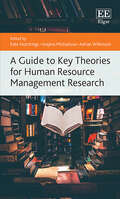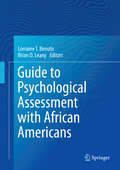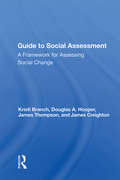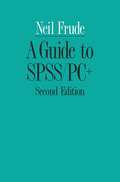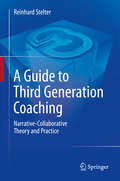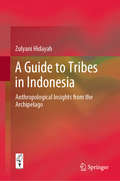- Table View
- List View
Guide to Ambient Intelligence in the IoT Environment: Principles, Technologies and Applications (Computer Communications and Networks)
by Zaigham MahmoodAmbient intelligence (AmI) is an element of pervasive computing that brings smartness to living and business environments to make them more sensitive, adaptive, autonomous and personalized to human needs. It refers to intelligent interfaces that recognise human presence and preferences, and adjust smart environments to suit their immediate needs and requirements. The key factor is the presence of intelligence and decision-making capabilities in IoT environments. The underlying technologies include pervasive computing, ubiquitous communication, seamless connectivity of smart devices, sensor networks, artificial intelligence (AI), machine learning (ML) and context-aware human-computer interaction (HCI). AmI applications and scenarios include smart homes, autonomous self-driving vehicles, healthcare systems, smart roads, the industry sector, smart facilities management, the education sector, emergency services, and many more. The advantages of AmI in the IoT environment are extensive. However, as for any new technological paradigm, there are also many open issues and limitations. This book discusses the AmI element of the IoT and the relevant principles, frameworks, and technologies in particular, as well as the benefits and inherent limitations. It reviews the state of the art of current developments relating to smart spaces and AmI-based IoT environments. Written by leading international researchers and practitioners, the majority of the contributions focus on device connectivity, pervasive computing and context modelling (including communication, security, interoperability, scalability, and adaptability). The book presents cutting-edge research, current trends, and case studies, as well as suggestions to further our understanding and the development and enhancement of the AmI-IoT vision.
A Guide to Children's Reference Books and Multimedia Material (Routledge Revivals)
by Susan HancockFirst published in 1998 , A Guide to Children’s Reference Books and Multi Material provides essential information on over 250 children’s reference products for parents, teachers and librarians wishing to purchase the best books and multimedia material in the late 90’s.
A Guide to Children's Reference Books and Multimedia Material (Routledge Revivals)
by Susan HancockFirst published in 1998 , A Guide to Children’s Reference Books and Multi Material provides essential information on over 250 children’s reference products for parents, teachers and librarians wishing to purchase the best books and multimedia material in the late 90’s.
A Guide to Commissioning Health and Wellbeing Services
by Amanda J. HughesAre you a health and social care commissioner navigating the ever-changing commissioning landscape? With challenges such as limited funding, changing demands and global pandemics, we need to be clear on why, what and how we commission effectively. This book offers you a warm welcome into the often-complex world of healthcare commissioning. Amanda J. Hughes shares personal insights from her commissioning career and practical guidance that will demystify the commissioning cycle and ease the journey as you strive to achieve the best outcomes for the population. This book will help you to ensure valuable resources are directed to those with most need, that care is fair and accessible and that the solutions you put into place are sustainable for the longer term.
A Guide to Commissioning Health and Wellbeing Services
by Amanda J. HughesAre you a health and social care commissioner navigating the ever-changing commissioning landscape? With challenges such as limited funding, changing demands and global pandemics, we need to be clear on why, what and how we commission effectively. This book offers you a warm welcome into the often-complex world of healthcare commissioning. Amanda J. Hughes shares personal insights from her commissioning career and practical guidance that will demystify the commissioning cycle and ease the journey as you strive to achieve the best outcomes for the population. This book will help you to ensure valuable resources are directed to those with most need, that care is fair and accessible and that the solutions you put into place are sustainable for the longer term.
Guide to Data Privacy: Models, Technologies, Solutions (Undergraduate Topics in Computer Science)
by Vicenç TorraData privacy technologies are essential for implementing information systems with privacy by design.Privacy technologies clearly are needed for ensuring that data does not lead to disclosure, but also that statistics or even data-driven machine learning models do not lead to disclosure. For example, can a deep-learning model be attacked to discover that sensitive data has been used for its training? This accessible textbook presents privacy models, computational definitions of privacy, and methods to implement them. Additionally, the book explains and gives plentiful examples of how to implement—among other models—differential privacy, k-anonymity, and secure multiparty computation.Topics and features:Provides integrated presentation of data privacy (including tools from statistical disclosure control, privacy-preserving data mining, and privacy for communications)Discusses privacy requirements and tools for different types of scenarios, including privacy for data, for computations, and for usersOffers characterization of privacy models, comparing their differences, advantages, and disadvantagesDescribes some of the most relevant algorithms to implement privacy modelsIncludes examples of data protection mechanismsThis unique textbook/guide contains numerous examples and succinctly and comprehensively gathers the relevant information. As such, it will be eminently suitable for undergraduate and graduate students interested in data privacy, as well as professionals wanting a concise overview.Vicenç Torra is Professor with the Department of Computing Science at Umeå University, Umeå, Sweden.
A Guide to European Town Directories: Volume One - Germany, Austria, Switzerland and Scandinavia. (Routledge Revivals)
by Gareth Shaw Tim ColesFirst published in 1997, European Directories is a major resource guide for urban historians and historical geographers. It provides a detailed bibliography of all directories published and available in major libraries throughout Germany, Austria, Switzerland, Denmark and Scandinavia. In addition, the book provides an account of the evolution of town directories, as well as giving an analysis of directory reliability and coverage. Researchers will also find an extensive bibliography for each country of literature that has utilized directory information in historical studies. The second volume includes France and southern Europe. The whole provides the first European-wide resource for those undertaking urban historical studies.
A Guide to European Town Directories: Volume One - Germany, Austria, Switzerland and Scandinavia. (Routledge Revivals)
by Gareth Shaw Tim ColesFirst published in 1997, European Directories is a major resource guide for urban historians and historical geographers. It provides a detailed bibliography of all directories published and available in major libraries throughout Germany, Austria, Switzerland, Denmark and Scandinavia. In addition, the book provides an account of the evolution of town directories, as well as giving an analysis of directory reliability and coverage. Researchers will also find an extensive bibliography for each country of literature that has utilized directory information in historical studies. The second volume includes France and southern Europe. The whole provides the first European-wide resource for those undertaking urban historical studies.
Guide to Framing Design Practice for UX (Synthesis Lectures on Human-Centered Informatics)
by John LongThe scope of the book is UX. It presents a comprehensive guide for readers to better engage with the framing of UX design practice. The guide characterises UX as a movement, whose members are developing shared ideas to specify and to implement HCI (Human-Computer Interaction) as UX. The book is based on the analysis of the conduct and reporting of framing UX design practice, contributed by experienced UX practitioners. It surveys the various means by which UX practitioners conduct and report their design practices. These include trial and error; implement, test, and specify; and implement, evaluate, and iterate. These practices apply UX frameworks, UX approaches, and UX methods and are typically reported in the form of UX case studies. The book differs from top-down, formal, and framework-driven approaches. In contrast, it takes a bottom-up, informal, and practice-driven approach. In a dynamic field such as UX, there is seldom time to stop and think about the wider issues associated with design practice and its related trends. But this book creates that opportunity for UX practitioners to locate and reflect on their design practice—what they are doing and why they are doing it. The guide creates a space in which UX practitioners are informed of current trends that they can incorporate into their own workflows. Readers benefiting from this book include those working in customer experience design, experience-centred design, and human experience design. It will also be of interest to undergraduate and graduate students trying to make sense of the different ways of conducting and reporting HCI as UX. Further, it provides grounding for young researchers making their way in the fast developing world of UX.
A Guide to Key Theories for Human Resource Management Research
This authoritative Guide provides 41 summaries of important theories used for research in human resource management (HRM). Each entry clearly defines a theory, provides insight into the development of the theory, demonstrates the application of the theory to HRM, and discusses areas where the theory could be applied in future research projects. The two introductory chapters overview HRM in relation to theory, and explain the importance of theory in research and issues to consider when using theory.In particular, the book offers:A concise summary of the origins of HRMA clear explanation of what is and what is not theoryDetailed suggestions for selecting and using theories for future research projectsAccessible summaries of theories used for HRM researchApplication of theories from various disciplines to HRMA Guide to Key Theories for Human Resource Management Research will be essential and reassuring reading for Master’s students and PhD candidates researching HRM. It will also benefit early career researchers and more established researchers seeking insight into more recently developed theories.
Guide to Non-Traditional Careers in Science: A Resource Guide for Pursuing a Non-Traditional Path
by Karen Y. KreegerOffering practical advice and stories from scientists and professionals, this guidebook aids the reader in evaluating and finding career opportunities in non-academic research fields. It demonstrates that choices are available, providing many examples of fields (for example publishing, law, public policy and business) in which people can use their scientific training to nurture a satisfying professional life. Yet it also acknowledges that there are trade-offs involved with any veer from the traditional path.
Guide to Non-Traditional Careers in Science: A Resource Guide for Pursuing a Non-Traditional Path
by Karen Y. KreegerOffering practical advice and stories from scientists and professionals, this guidebook aids the reader in evaluating and finding career opportunities in non-academic research fields. It demonstrates that choices are available, providing many examples of fields (for example publishing, law, public policy and business) in which people can use their scientific training to nurture a satisfying professional life. Yet it also acknowledges that there are trade-offs involved with any veer from the traditional path.
Guide to Psychological Assessment with African Americans
by Lorraine T. Benuto Brian D. LeanyThe movements toward cultural sensitivity and evidence-based practice are watershed developments in clinical psychology. As a population with a long history of substandard treatment from mental health systems, African Americans have especially benefitted from these improvements. But as with other racial and ethnic minorities, finding relevant test measures in most psychological domains presents clinicians with an ongoing challenge. The Guide to Psychological Assessment with African Americans aims to close the evaluation/therapy gap by giving practitioners the tools to choose appropriate instruments while respecting client individuality. Expert contributors analyze scarce and far-flung data, identify strengths and limitations of measures and norms in their use with African-American clients, and advise on avoiding biases in interpreting results. The editors advocate for a theory-based hypothesis-testing approach to assessment when empirical evidence is lacking, and offer guidelines for decision-making that is effective as well as ethnically aware. The Guide's findings, insights, and practical information cover the gamut of test and diagnostic areas, including: IQ and personality.Generalized anxiety disorder, panic, and phobias.Neuropsychological assessment, cognitive decline, and dementia.Mood disorders and suicidality.Forensic assessment, risk, and recidivism.Measures specific to children and adolescents.Plus PTSD, substance disorders, eating pathology, and more. Expertly complementing cross-cultural treatment texts, the Guide to Psychological Assessment with African Americans stands out as a trustworthy resource for treatment planning useful to clinical psychologists, neuropsychologists, and clinical social workers.
Guide to Psychological Assessment with Asians
by Lorraine T. Benuto Nicholas S. Thaler Brian D. LeanyTo effectively serve minority clients, clinicians require a double understanding: of both evidence-based practice and the cultures involved. This particularly holds true when working with Asian-Americans, a diverse and growing population.The Guide to Psychological Assessment with Asians synthesizes real-world challenges, empirical findings, clinical knowledge and common-sense advice to create a comprehensive framework for practice. This informed resource is geared toward evaluation of first-generation Asian Americans and recent immigrants across assessment methods (self-report measures, projective tests), settings (school, forensic) and classes of disorders (eating, substance, sexual). While the Guide details cross-cultural considerations for working with Chinese-, Japanese-, Korean and Indian-American clients, best practices are also included for assessing members of less populous groups without underestimating, overstating or stereotyping the role of ethnicity in the findings. In addition, contributors discuss diversity of presentation within groups and identify ways that language may present obstacles to accurate evaluation. Among the areas covered in this up-to-date reference:Structured and semi-structured clinical interviews.Assessment of acculturation, enculturation and culture.IQ testing.Personality disorders.Cognitive decline and dementia.Mood disorders and suicidality.Neuropsychological assessment of children, adolescents and adults.Culture-bound syndromes.Designed for practitioners new to working with Asian clients as well as those familiar with the population, the Guide to Psychological Assessment with Asians is exceedingly useful to neuropsychologists, clinical psychologists, health psychologists and clinical social workers.
Guide to Psychological Assessment with Hispanics
by Lorraine T. BenutoThis book focuses on diversity, culture, and ethnicity as they relate to psychological assessment of Hispanics. It is a how-to guide for clinicians, researchers, and instructors working with Hispanic clients. Each chapter contains an overview of cultural considerations needed for assessing the Hispanic client followed by a specific exploration of the assessment measures available and the research that has been conducted on these measures with Hispanic participants. An exploration of the strengths and limitations of each assessment measure is included. Considering that ethnocultural minority individuals who are of Hispanic/Latino origin make up the largest ethnocultural minority group in the United States, guidelines for working with this population are a must. Given that a large subset of this percentage is composed of immigrants many of whom do not speak English or who have learned English as a second language, special considerations for effective psychological assessment are neccessary.This book fills a gap in the scientific literature by consolidating the research on psychological assessment with Hispanic samples into one comprehensive volume and providing simple recommendations for the psychological assessment of Hispanic clients. An exploration of the general psychological assessment domains (e.g., personality, intelligence) is included with references to research on the major assessment measures used in the field. A more specific exploration of psychodiagnostic assessment measures follows, including the assessment of mood disorders, anxiety disorders, sexual dysfunction, psychosis, etc. Several chapters are dedicated to specialized assessment, including neuropsychological assessment, forensic assessment, and school-based assessment, overall creating the most comprehensive, up-to-date, research-based compendium of psychological assessment measures for use with Hispanic clients.
A Guide to Slavic Collections in the United States and Canada
by Allan Urbanic Beth FeinbergGet access to the Slavic and East European research materials you needA Guide to Slavic Collections in the United States and Canada presents up-to-date information on 85 North American libraries that house Slavic and East European research materials, providing current details on recent acquisitions, developments in collection policies, and changes in contact information. Using individual entries written by each institution&’s librarian or archivist, you&’ll save valuable time and effort in your search for resources on Russia and the rest of the former Soviet Union, Poland, the Czech and Slovak Republics, the former Yugoslavia, the Baltic countries, Bulgaria, Albania, Hungary, Romania, and the Sorbs in Germany. This unique book includes facts and figures on special collections, finding aids, catalogs, Web access, and bibliographies for further readings.A Guide to Slavic Collections in the United States and Canada examines collections available at public libraries, governmental libraries, special collections, and university libraries. Edited by Dr. Allan Urbanic, Librarian for Slavic and East European Collections at the University of California, Berkeley, and Slavic Collection Manager at the University of California, Santa Barbara, and Beth Feinberg, Slavic Catalog Librarian at the University of California, Los Angeles, the book lists current and retrospective materials collected in print, microform, and electronic formats, and includes monographs, serial publications, reference works, dissertations, and conference proceedings. Entries for A Guide to Slavic Collections in the United States and Canada include: access policy for visits general collection description special collection description online catalog archive collections size of collection percent of collection in vernacular language electronic resources and much more!A Guide to Slavic Collections in the United States and Canada is an essential, time-saving resource for librarians and academics looking for research materials.
A Guide to Slavic Collections in the United States and Canada
by Allan Urbanic Beth FeinbergGet access to the Slavic and East European research materials you needA Guide to Slavic Collections in the United States and Canada presents up-to-date information on 85 North American libraries that house Slavic and East European research materials, providing current details on recent acquisitions, developments in collection policies, and changes in contact information. Using individual entries written by each institution&’s librarian or archivist, you&’ll save valuable time and effort in your search for resources on Russia and the rest of the former Soviet Union, Poland, the Czech and Slovak Republics, the former Yugoslavia, the Baltic countries, Bulgaria, Albania, Hungary, Romania, and the Sorbs in Germany. This unique book includes facts and figures on special collections, finding aids, catalogs, Web access, and bibliographies for further readings.A Guide to Slavic Collections in the United States and Canada examines collections available at public libraries, governmental libraries, special collections, and university libraries. Edited by Dr. Allan Urbanic, Librarian for Slavic and East European Collections at the University of California, Berkeley, and Slavic Collection Manager at the University of California, Santa Barbara, and Beth Feinberg, Slavic Catalog Librarian at the University of California, Los Angeles, the book lists current and retrospective materials collected in print, microform, and electronic formats, and includes monographs, serial publications, reference works, dissertations, and conference proceedings. Entries for A Guide to Slavic Collections in the United States and Canada include: access policy for visits general collection description special collection description online catalog archive collections size of collection percent of collection in vernacular language electronic resources and much more!A Guide to Slavic Collections in the United States and Canada is an essential, time-saving resource for librarians and academics looking for research materials.
Guide To Social Impact Assessment: A Framework For Assessing Social Change
by Kristi BranchDesigned to provide clear and detailed assistance in the complex process of assessing social change, this book emphasizes the development of an analytic approach and a theoretical framework that can be applied to the assessment of very diverse events--changes in the natural environment, the local economy, or the dominant technology. The guide, based on a sociological perspective that highlights the importance of community social organization in analyzing social change, focuses on the development of user skills in assessment design, research, analysis, and presentation. The guide's theoretical basis and emphasis on the interrelationships that create social change make it valuable to those studying social change in general, as well as to those responsible for conducting or utilizing social impact assessments. Detailed "how to" information, clear writing, and careful design impart the skills necessary to identify and analyze the factors and processes leading to social change and to interpret and present research findings in an effective manner.
Guide To Social Impact Assessment: A Framework For Assessing Social Change
by Kristi BranchDesigned to provide clear and detailed assistance in the complex process of assessing social change, this book emphasizes the development of an analytic approach and a theoretical framework that can be applied to the assessment of very diverse events--changes in the natural environment, the local economy, or the dominant technology. The guide, based on a sociological perspective that highlights the importance of community social organization in analyzing social change, focuses on the development of user skills in assessment design, research, analysis, and presentation. The guide's theoretical basis and emphasis on the interrelationships that create social change make it valuable to those studying social change in general, as well as to those responsible for conducting or utilizing social impact assessments. Detailed "how to" information, clear writing, and careful design impart the skills necessary to identify and analyze the factors and processes leading to social change and to interpret and present research findings in an effective manner.
A Guide to SPSS/PC+
by Neil FrudeWritten for those with little or no experience in using computers for statistical analysis, this book introduces SPSS/PC+, the market leader PC package. A Guide to SPSS/PC+ teaches the use of SPSS/PC+ clearly and simply. Following the book, which is organized as a progressive tutorial, readers can analyze their own data, or may follow worked examples using the complete dataset which is included. The appendices provide a comprehensive guide for beginners and for those needing to revise their SPSS/PC+ skills. A Guide to SPSS/PC+ is now in its second edition and has been revised to cover the new developments available within Version 4.0 of SPSS/PC.
A Guide to Systems Research: Philosophy, Processes and Practice (Translational Systems Sciences #10)
by Mary C. Edson Pamela Buckle Henning Shankar SankaranThis guide is designed for systems researchers – emerging and seasoned – searching for holistic approaches of inquiry into complexity, which the Systems Sciences provide. The authors share insight into the foundations of research that are not only systematic in terms of rigor, but systemic in perspective, analysis, design, development, implementation, reporting, and evaluation. This guide also explores researcher competencies necessary to conduct sound systems research. Researchers using this guide will gain understanding of what distinguishes systems research from other types of research and why it is important in research today.
A Guide to the Systems of Provision Approach: Who Gets What, How and Why
by Kate Bayliss Ben FineUnderstanding consumption requires looking at the systems by which goods and services are provided – not just how they are produced but the historically evolved structures, power relations and cultures within which they are located. The Systems of Provision approach provides an interdisciplinary framework for unpacking these complex issues. This book provides a comprehensive account of the Systems of Provision approach, setting out core concepts and theoretical origins alongside numerous case studies. The book combines fresh understandings of everyday consumption using examples from food, housing, and water, with implications for society’s major challenges, including inequality, climate change, and prospects for capitalism. Readers do not require prior knowledge across the subject matter covered but the text remains significant for accomplished researchers and policymakers, especially those interested in the messy real world realities underpinning who gets what, how, and why across public and private provision in global, national, and historical contexts.
A Guide to Third Generation Coaching: Narrative-Collaborative Theory and Practice
by Reinhard StelterThird generation coaching proposes a form of dialogue where coach and coachee are focused on creating space for reflection through collaborative practices and less concerned with fabricating quick solutions. Aspiring to achieve moments of symmetry between coach and coachee, where their dialogue is driven by a strong emphasis on meaning-making, values, aspirations and identity issues. Coach and coachee meet as fellow-humans in a genuine dialogue.Marking a new trend in coaching, based on the acknowledgement of changes in society, learning and knowledge production, as well as leadership, while distinguishing itself from the existing models (pop coaching, GROW model, etc.). Third generation coaching is based on a fresh analysis of our society – a society that is characterized by diversification, identity challenges, abolition of the monopoly of knowledge, lifelong learning, and the necessity for self-reflection. Providing quality material to guide ambitious practitioners and high level coaching education programs, in an accessible format. A Guide to Third Generation Coaching advocates a revisited and innovative approach to coaching and coaching psychology, advantageous for learners and practitioners alike, by supporting the reader as a reflective practitioner. ”In this insightful book Reinhard Stelter takes coaching to a new level. With its new perspective, it will make an outstanding contribution to the field.”Prof Stephen Palmer, Centre for Coaching, London, UK, President of the International Society for Coaching Psychology (ISCP) “This book is a wonderful contribution to further theoretical understanding and evidence-based practice within Coaching and Coaching Psychology. Reinhard provides us with a look at the foundations contributing to this field, the benefit of his experience and learning, and the evolution of thinking to our current state. Whether you are a coach, coaching psychologist, leader, manager or student, you will find this an excellent resource to expand your thinking, reflection, exploration, and learning on your journey.” Diane Brennan, MBA, MCC, Past-President International Coach Federation (ICF) in 2008 “A thoughtful and wide ranging journey through the philosophy of coaching. Professor Stelter brings positive psychology, dialogue, and narrative approaches together into a model of coaching designed to meet the needs of clients in today’s world.”Dr. Michael Cavanagh, MClinPsy, PhD, Deputy Director, Coaching Psychology Unit, School of Psychology, The University of Sydney
A Guide to Tribes in Indonesia: Anthropological Insights from the Archipelago
by Zulyani HidayahThis encyclopedia provides a comprehensive overview of the traditions, cultures, kinship norms, and other significant cultural aspects of the tribes, or otherwise named ethnic groups, of Indonesia, by an Indonesian anthropologist. The entries are supported by illustrations drawn by the late author himself, and are also accompanied by maps indicating the geographic locations and distributions of each tribe throughout the vast archipelago. Originally written and published in Bahasa Indonesian, the text has been translated into English and revised to feature up-to-date information. In showcasing the extent of diversity and the distinctiveness of the numerous tribal cultures in Indonesia, the volume presents itself as an important academic reference in Indonesian anthropology and ethnography studies, now finally available to global readership. Intended as a short work of reference, it will be indispensable to students and scholars researching Indonesia from anthropological, sociocultural, and ethnographic perspectives.
A Guide To U.S. Aircraft Noise Regulatory Policy (Springerbriefs In Applied Sciences And Technology Ser.)
by Sanford Fidell Vincent MestreAviation noise remains the primary hindrance to expansion of airport and airspace capacity in the United States. This book describes the development and practice of U.S. aircraft noise regulation, as well as the practical consequences of regulatory policy. Starting in the pre-jet transport era, the book traces the development of the modern framework for characterizing, standardizing, predicting, disclosing, and mitigating aircraft noise and its effects on airport-vicinity communities. Among other matters, the book treats noise-related consequences of the 1978 deregulation of the airline industry; prediction and mitigation of community reaction to airport noise; land use compatibility planning; recent research and industry trends; and some suggestions for potential improvements to current policy. Initial chapters describe the assumptions underlying aircraft noise regulation, and lay out the chronology of U.S. aircraft noise regulatory practice. Later chapters provide overviews of population-level effects of aviation noise, including health effects, speech and sleep interference, and annoyance. Readers will learn why predictions of the prevalence of aircraft noise-induced annoyance have systematically underestimated adverse community response to aircraft noise, and how such underestimation has complicated approval and funding of airport and airspace improvement projects. They will also learn why attempts at noise-compatible land use planning are seldom fully successful.






